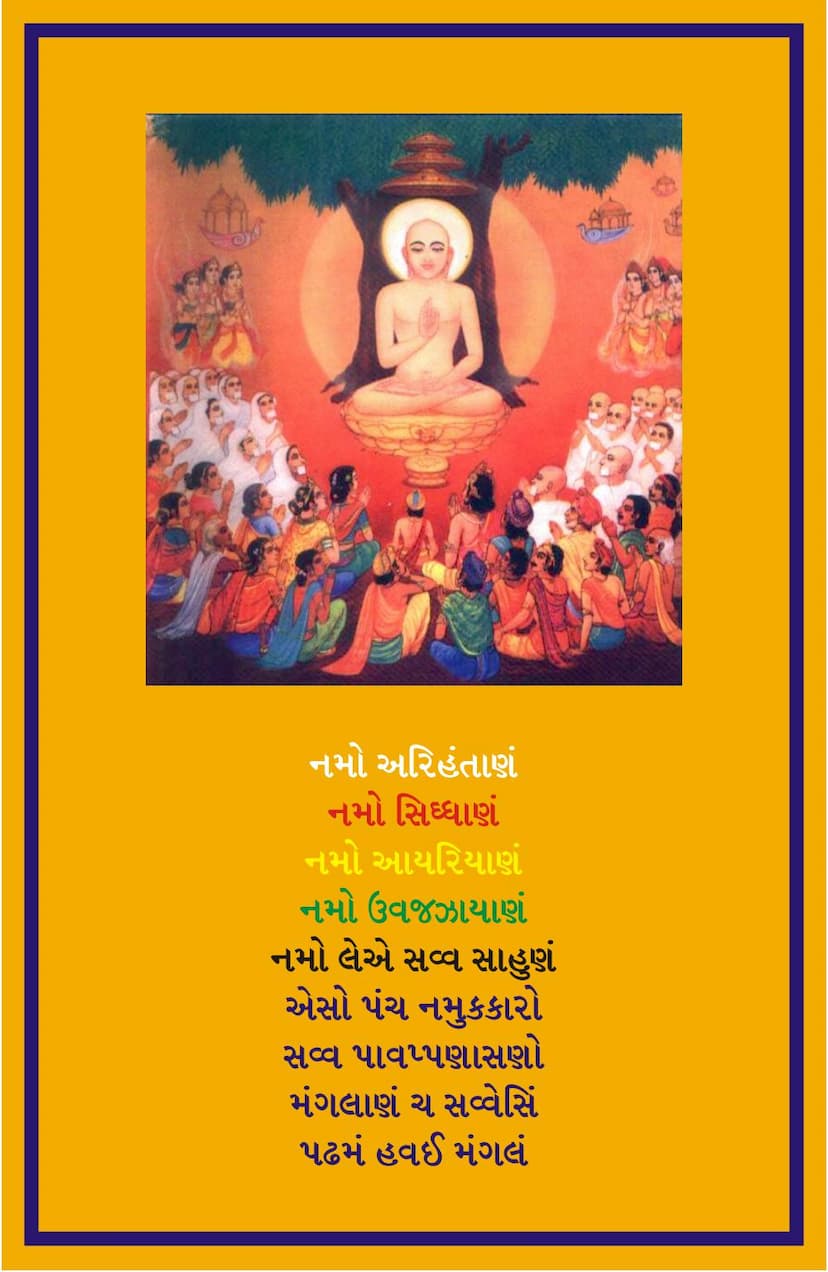Agam 09 Ang 09 Anuttaropapatik Sutra Sthanakvasi Gujarati
Added to library: September 1, 2025

Summary
This document is a Gujarati translation and commentary of the Anuttaropapātik Sūtra, which is the ninth Anga (limb or section) of the Jain Agamas, specifically from the Sthanakvasi tradition. It's part of the "Agam 09 Ang 09" series. The commentary is by Ghasilal Maharaj, and the publisher is A B Shwetambar Sthanakvasi Jain Shastroddhar Samiti.
Here's a breakdown of the key information and content presented in the provided pages:
1. Title and Author:
- Title: Shri Anuttaropapātik Sūtra (श्री अनुत्तरोपपातिक सूत्रा)
- Commentary (Tika): Arthabodhini (अर्थबोधिनि)
- Author of Commentary: Ghasilal Maharaj (घासीलालजी महाराज)
- Translator/Editor/Coordinator: Pandit Muni Shri Kanhaiyalalji Maharaj (पण्डितमुनि-श्रीकन्हैयालालजी-महाराजः)
- Publisher: Akhil Bharat Shwetambar Sthanakvasi Jain Shastroddhar Samiti (अखिल भारत श्वेताम्बर स्थानकवासी जैन शास्त्रोद्धार समिति)
- Edition: Second Edition (द्वितीया आवृत्तिः)
- Year of Publication: Vikram Samvat 2015 (1959 CE), Vir Samvat 2485.
2. Introduction and Purpose:
- The text begins with the Panch Namaskara Mantra (नमो अरिहंतानां... नमो लोए सव्वसाहूणं), a fundamental prayer in Jainism.
- It highlights the Anuttaropapātik Sūtra as the ninth Anga, which describes the lives and spiritual journeys of individuals who attain the highest state of existence (Anuttar Viman).
- The commentary aims to provide an "Arthabodhini" (meaning-understanding) explanation, making the profound teachings accessible.
3. Structure of the Sūtra:
- The Sūtra is divided into three main Vargs (sections or classes).
- Each Varg contains a number of Adhyayans (chapters or lessons).
- First Varg: 10 Adhyayans
- Second Varg: 13 Adhyayans
- Third Varg: 10 Adhyayans
- The total number of Pad (words/syllables) is stated to be 4,608,000 (छेताळीस लाख आठ हजार).
4. Key Themes and Content:
- Mangalacharan (Invocation): The text starts with invocations to Lord Mahavir and the Acharyas.
- Shastra Parichay (Introduction to the Scripture): It explains the scope of the scripture, mentioning topics like cities, gardens, Samavasaran (divine assembly), names of kings and parents, dharma acharyas, religious discourses, worldly and otherworldly prosperity, renunciation, initiation, scripture acquisition, austerities, vows, obstacles, fasting unto death (Sallekhana), rebirth in Anuttar Vimana, rebirth in good families, attainment of Samyaktva (right faith), and liberation (Moksha).
- Samavasaran Description: It details the divine assembly held by the Tirthankaras, including the role of attendant deities in creating a pure and auspicious environment. It emphasizes that the offerings (like flowers and water) must be inanimate (achet) to avoid harm to living beings, as a pure Jain practice.
- Savadya Puja Nishedh (Prohibition of Impure Worship): The text strongly condemns any worship involving harm (savadya) to living beings, particularly the six classes of living beings (shatkaya). It explains how such impure worship leads to karmic bondage and perpetuates the cycle of birth and death.
- The Concept of Pudgalapravarta: A significant portion explains the complex concept of Pudgalapravarta (cycle of material atoms), which is described as the process of living beings interacting with and undergoing transformations through various types of matter (like audarika, vaikriya, taijasa, karmic bodies, mind, speech, and breath). This concept is linked to the immense duration of transmigration in the Jain worldview.
- Lives of Illustrious Disciples (Kumars): The bulk of the Sūtra (as explained in the commentary) recounts the lives of various princes (Kumars) who achieved spiritual heights. These narratives serve as examples of renunciation, penance, and the path to liberation. Notable individuals include:
- Jalikumar: His story is detailed, covering his birth, upbringing, renunciation, severe austerities, and eventual rebirth in an Anuttar Vimana.
- Malikumar and others (9 more): The lives of 9 other princes are summarized, following a similar pattern of renunciation and spiritual attainment, culminating in rebirth in Anuttar Vimanas.
- Dirghasena and 13 others: The second section describes the lives of 13 more princes who also renounced the world, practiced austerities, and attained high spiritual states.
- Dhanyakumar and others (9 more): The third section begins by detailing the life of Dhanyakumar, his royal upbringing, renunciation, rigorous austerities (particularly the chhat-chhat fast with ayambil), and his eventual rebirth in an Anuttar Vimana. The lives of 9 other princes are then summarized, following similar paths.
- Dhanyakumar's Austerities and Devotion: The text elaborates on Dhanyakumar's extreme penances, describing the physical deterioration of his body due to severe austerities, yet highlighting his inner spiritual radiance. His interactions with Lord Mahavir and his deep renunciation are emphasized.
- The Goal of Liberation: The ultimate goal described is liberation (Moksha), achieved by shedding all karmas and attaining the state of Siddha (the perfected soul). The Anuttar Vimanas are described as the highest abodes before final liberation.
- Detailed Descriptions of Austerities: The commentary provides vivid descriptions of Dhanyakumar's penances, using numerous similes and metaphors to illustrate the extreme emaciation and spiritual fortitude of his body.
- Praise for Dhanyakumar: King Shrenik's admiration for Dhanyakumar's dedication and spiritual achievements is described, including a hymn of praise.
- Niyamas (Rules) for Swadhyaya (Recitation/Study): Pages 6-10 detail specific rules and auspicious/inauspicious times (swadhyaya and aswadhyaya) for the study of the original text, including periods of interruption due to celestial phenomena (meteor showers, lightning), bodily conditions (menstruation), and specific events (eclipses, deaths, festivals).
5. Commentary Style:
- The commentary by Ghasilal Maharaj seems to be explanatory and devotional, aiming to elucidate the scriptural meanings and inspire the reader.
- The text frequently references other Jain scriptures like the Nandisūtra and Bhagavatī Sūtra to support its explanations.
In essence, this publication is a scholarly and devotional work making the teachings of the Anuttaropapātik Sūtra accessible to Gujarati-speaking Jain followers of the Sthanakvasi tradition, focusing on the lives of spiritual exemplars who achieved supreme states of existence through renunciation, austerities, and right faith.